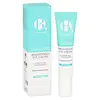What's inside
What's inside
 Key Ingredients
Key Ingredients

 Benefits
Benefits

 Concerns
Concerns

No concerns
 Ingredients Side-by-side
Ingredients Side-by-side

Water
Skin ConditioningCaprylic/Capric Triglyceride
MaskingCaffeine
Skin ConditioningPropanediol
SolventBoron Nitride
AbsorbentDodecane
PerfumingMethylpropanediol
SolventNiacinamide
SmoothingSodium Acrylates Copolymer
Xylitylglucoside
HumectantAnhydroxylitol
HumectantLecithin
EmollientXylitol
HumectantButylene Glycol
HumectantCaprylyl Glycol
EmollientPhenoxyethanol
PreservativeTocopheryl Acetate
AntioxidantDisodium EDTA
Sodium Hydroxide
BufferingGlucose
HumectantAcetyl Tetrapeptide-5
HumectantWater, Caprylic/Capric Triglyceride, Caffeine, Propanediol, Boron Nitride, Dodecane, Methylpropanediol, Niacinamide, Sodium Acrylates Copolymer, Xylitylglucoside, Anhydroxylitol, Lecithin, Xylitol, Butylene Glycol, Caprylyl Glycol, Phenoxyethanol, Tocopheryl Acetate, Disodium EDTA, Sodium Hydroxide, Glucose, Acetyl Tetrapeptide-5
Water
Skin ConditioningCaprylic/Capric Triglyceride
MaskingPropylene Glycol
HumectantButyrospermum Parkii Butter
Skin ConditioningIsopropyl Myristate
EmollientGlyceryl Stearate
EmollientDimethicone
EmollientPolyglyceryl-3 Methylglucose Distearate
EmulsifyingCaffeine
Skin ConditioningStearyl Alcohol
EmollientPhenoxyethanol
PreservativeCoffea Arabica Seed Extract
MaskingBetaine
HumectantStearic Acid
CleansingCaprylyl Glycol
EmollientCarbomer
Emulsion StabilisingGlycerin
HumectantXanthan Gum
EmulsifyingButylene Glycol
HumectantLecithin
EmollientTocopheryl Acetate
AntioxidantDisodium EDTA
Sodium Hydroxide
BufferingTetrapeptide-21
Skin ConditioningWater, Caprylic/Capric Triglyceride, Propylene Glycol, Butyrospermum Parkii Butter, Isopropyl Myristate, Glyceryl Stearate, Dimethicone, Polyglyceryl-3 Methylglucose Distearate, Caffeine, Stearyl Alcohol, Phenoxyethanol, Coffea Arabica Seed Extract, Betaine, Stearic Acid, Caprylyl Glycol, Carbomer, Glycerin, Xanthan Gum, Butylene Glycol, Lecithin, Tocopheryl Acetate, Disodium EDTA, Sodium Hydroxide, Tetrapeptide-21
 Reviews
Reviews

Ingredients Explained
These ingredients are found in both products.
Ingredients higher up in an ingredient list are typically present in a larger amount.
Butylene Glycol (or BG) is used within cosmetic products for a few different reasons:
Overall, Butylene Glycol is a safe and well-rounded ingredient that works well with other ingredients.
Though this ingredient works well with most skin types, some people with sensitive skin may experience a reaction such as allergic rashes, closed comedones, or itchiness.
Learn more about Butylene GlycolCaffeine is most associated with coffee, tea, and cacao. In skincare, it helps with calming inflammation and is rich in antioxidants.
While caffeine is used to treat cellulite and and dark circles, further studies are needed to prove this. It has been believed to help with these skin conditions due to its ability to dilate blood vessels and increase blood flow.
Some studies are looking into caffeine's ability to protect against UV rays.
Learn more about CaffeineThis ingredient is an emollient, solvent, and texture enhancer. It is considered a skin-softener by helping the skin prevent moisture loss.
It helps thicken a product's formula and makes it easier to spread by dissolving clumping compounds.
Caprylic Triglyceride is made by combining glycerin with coconut oil, forming a clear liquid.
While there is an assumption Caprylic Triglyceride can clog pores due to it being derived from coconut oil, there is no research supporting this.
Learn more about Caprylic/Capric TriglycerideCaprylyl Glycol is a humectant and emollient, meaning it attracts and preserves moisture.
It is a common ingredient in many products, especially those designed to hydrate skin. The primary benefits are retaining moisture, skin softening, and promoting a healthy skin barrier.
Though Caprylyl Glycol is an alcohol derived from fatty acids, it is not the kind that can dry out skin.
This ingredient is also used as a preservative to extend the life of products. It has slight antimicrobial properties.
Learn more about Caprylyl GlycolDisodium EDTA plays a role in making products more stable by aiding other preservatives.
It is a chelating agent, meaning it neutralizes metal ions that may be found in a product.
Disodium EDTA is a salt of edetic acid and is found to be safe in cosmetic ingredients.
Learn more about Disodium EDTALecithin is a term for a group of substances found in the cell membranes of plants, animals, and humans. They are made up of mixture of phospholipids.
This ingredient has emollient and emulsifying properties.
As an emollient, lecithen helps soften the skin and creates a barrier to keep moisture in.
As an emulsifier, it also helps prevent water and oil ingredients from separating. Lecithin can also help ingredients be better absorbed by the skin.
This is because the phospholipids in lecithin produce liposomes. Liposomes help other ingredients get through the skin barrier.
Depending on the source of this ingredient, lecithin may not be fungal acne safe. This is because some sources of lecithin come from soybean oil, which may feed the malassezia yeast that feeds fungal acne.
We recommend reaching out to the brand you are purchasing from to inquire about the source of their lecithin.
Some other names for this ingredient include soy lecithin and deoiled soy lecithin.
Learn more about LecithinPhenoxyethanol is a preservative that has germicide, antimicrobial, and aromatic properties. Studies show that phenoxyethanol can prevent microbial growth. By itself, it has a scent that is similar to that of a rose.
It's often used in formulations along with Caprylyl Glycol to preserve the shelf life of products.
Sodium Hydroxide is also known as lye or caustic soda. It is used to adjust the pH of products; many ingredients require a specific pH to be effective.
In small amounts, sodium hydroxide is considered safe to use. However, large amounts may cause chemical burns due to its high alkaline.
Your skin has a natural pH and acid mantle. This acid mantle helps prevent harmful bacteria from breaking through. The acid mantle also helps keep your skin hydrated.
"Alkaline" refers to a high pH level. A low pH level would be considered acidic.
Learn more about Sodium HydroxideTocopheryl Acetate is AKA Vitamin E. It is an antioxidant and protects your skin from free radicals. Free radicals damage the skin by breaking down collagen.
One study found using Tocopheryl Acetate with Vitamin C decreased the number of sunburned cells.
Tocopheryl Acetate is commonly found in both skincare and dietary supplements.
Learn more about Tocopheryl AcetateWater. It's the most common cosmetic ingredient of all. You'll usually see it at the top of ingredient lists, meaning that it makes up the largest part of the product.
So why is it so popular? Water most often acts as a solvent - this means that it helps dissolve other ingredients into the formulation.
You'll also recognize water as that liquid we all need to stay alive. If you see this, drink a glass of water. Stay hydrated!
Learn more about Water